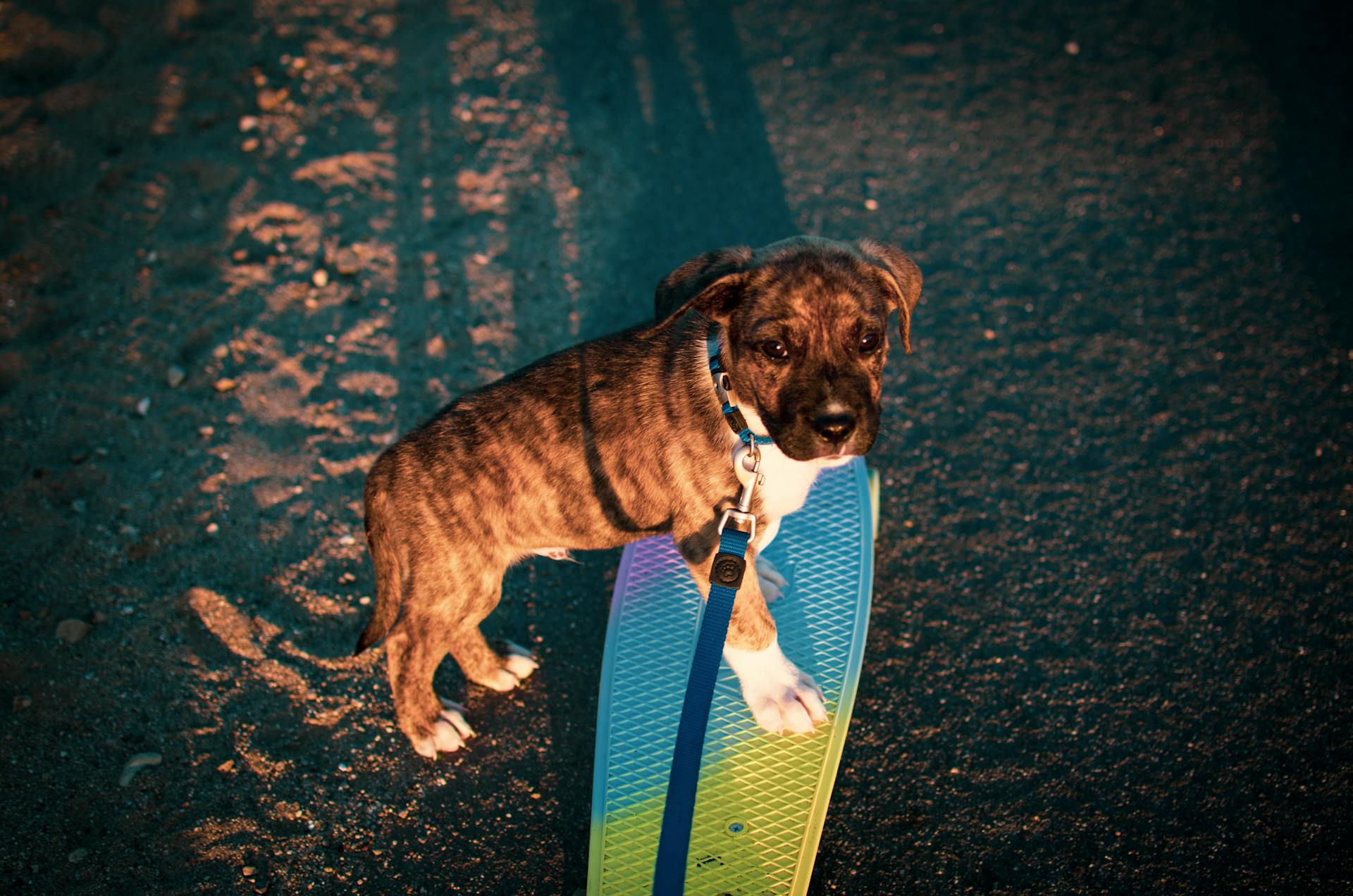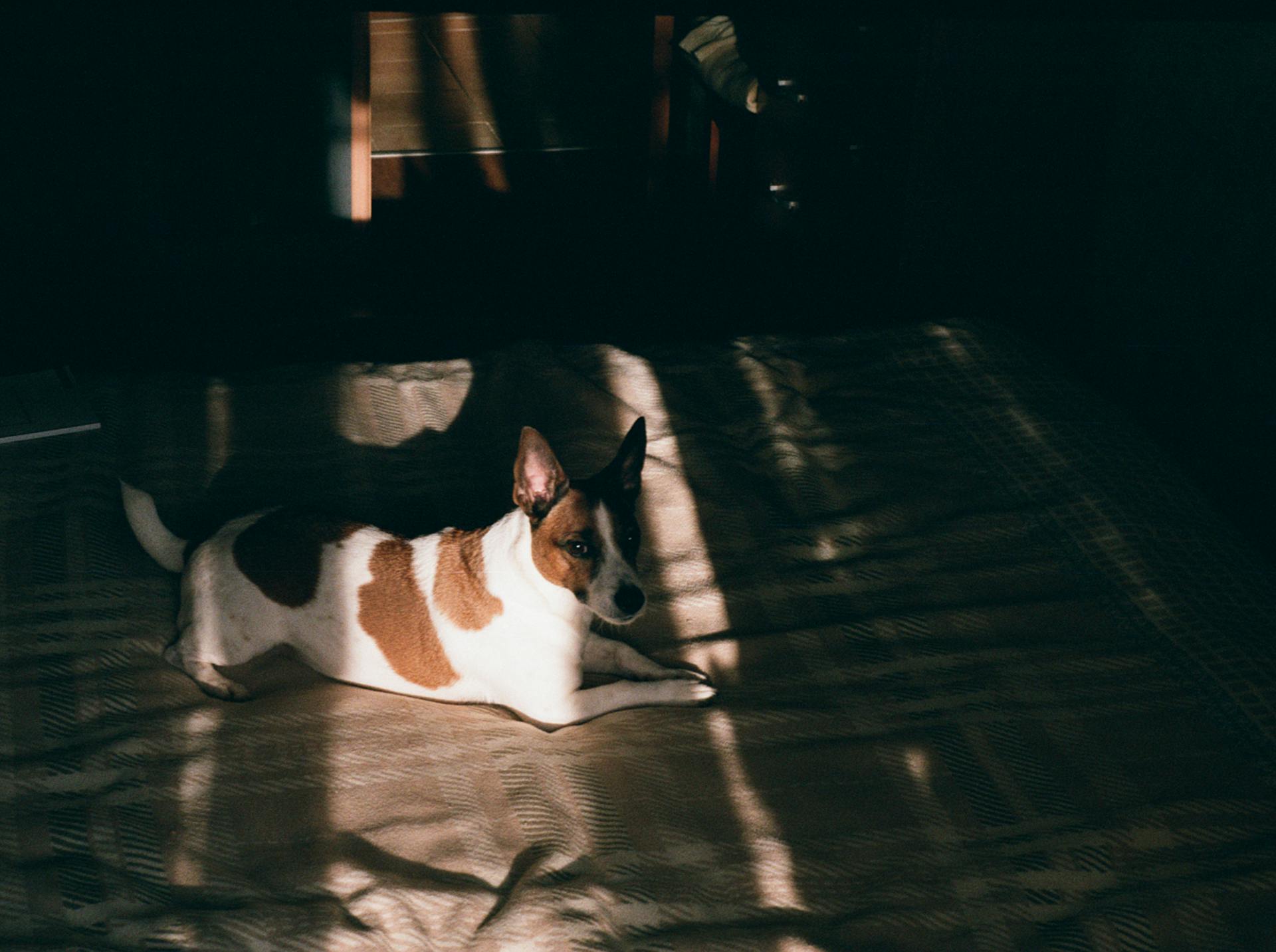
The Basenji is an ancient dog breed that originated in Africa over 2,000 years ago.
Basenjis are known for their unique yodeling howl, which they use to communicate with their human family and other dogs. They can be quite vocal, but they're not typically barkers - you'll hear a lot of howling instead!
This breed is often described as independent and strong-willed, requiring an owner who can match their confidence and assertiveness.
On a similar theme: Basenji Benji Dog Breed
Basenji Basics
The Basenji breed originated in Central Africa, specifically in the Congo region.
They are a medium-sized dog, weighing between 22-24 pounds and standing around 16 to 17 inches at the shoulder. Their sleek and muscular build is complemented by their short coat, which comes in various colors including red, black, tricolor, and brindle.
Basenjis have a unique characteristic of not barking in the traditional sense, instead producing a distinctive yodel-like sound called a "barroo." They are also known for being quiet dogs overall.
Quick Facts
The Basenji is a breed that originated from Central Africa and typically weighs between 22-24 pounds (10-11 kg). They belong to the Hound Group.
Their lifespan is relatively long, with an average of 12-16 years. This is great news for anyone considering bringing one home!
Basenjis have a short, fine coat that comes in various colors such as red, black, tricolor, and brindle. Their grooming needs are minimal due to this short coat.
These dogs are known for their unique "barkless" traits and cat-like grooming habits. They're intelligent, independent, and alert, making them quite fascinating companions.
Here's a quick rundown of the Basenji's exercise needs:
* Exercise Needs:
+ Moderate exercise requirements
+ Enjoy physical activities
+ Mental stimulation is equally important
Training a Basenji requires patience and consistency. They have a strong hunting instinct and can be stubborn at times, so positive reinforcement is key.
Regular veterinary check-ups are essential to ensure the overall health of your Basenji. They're generally a healthy breed but may be prone to conditions like hip dysplasia and kidney problems.
Overview
Basenjis are of medium size, standing around 16 to 17 inches at the shoulder and weighing between 22 to 24 pounds. This makes them a compact companion for active owners who can provide regular exercise.
One of the most notable characteristics of Basenjis is their quiet nature - they don't bark like other breeds, but instead produce a distinctive "barroo" sound. This trait makes them particularly appealing to those seeking a quieter breed.
Basenjis are intelligent and highly independent dogs with a strong prey drive, stemming from their hunting background in Africa. They may not be the best fit for households with small pets like cats or rodents, as they tend to chase smaller animals.
Here are some key characteristics of Basenjis:
- Quiet
- Low shedder
- Good for active owners
- High prey drive
- Can be stubborn about training
- Becomes bored and potentially destructive easily
Despite their independent streak, Basenjis are affectionate with their families and can be quite playful. They require regular exercise to expend their energy and enjoy activities such as running, hiking, and agility.
Physical Characteristics
Basenjis are small dogs with a unique appearance. They typically weigh around 20-24 pounds and stand about 16-18 inches tall at the shoulder.
Their coats come in various colors like rich chestnut red, black, tricolor, brindle, and even a rare combination called trindle. These striking colors often feature white markings on their feet, chests, tail tips, and sometimes legs or face.
Male Basenjis are usually larger than females, with males weighing around 24 pounds compared to the female's 22 pounds.
Suggestion: Basenji Dog Colors
Size
Size is a notable aspect of the Basenji breed. Male Basenjis typically have a shoulder height of around 17 inches.
The weight range for males is approximately 24 pounds. This makes them a relatively small dog breed overall.
Females are slightly smaller, with an average shoulder height of about 16 inches. Their weight is also lower, at around 22 pounds.
You might like: Basenji Weight
Appearance
Basenjis are small dogs, typically weighing about 9–11 kg (20–24 lb) and standing 41–46 cm (16–18 in) at the shoulder.
Their forehead is wrinkled, even more so when they're young or extremely excited, giving them a unique appearance. A Basenji's eyes are almond-shaped, adding to their distinctive features.
They have erect ears and tightly curled tails, which can straighten out for greater balance when running at top speed. This athletic build makes them deceptively powerful for their size.
Basenjis come in various colorations, including red, black, tricolor, brindle, and a rare combination called trindle. They all have white feet, chests, and tail tips.
A Basenji's gait is similar to that of a trotting horse, with a double suspension gallop that allows them to skim the ground effortlessly.
Coat Color and Grooming
The Basenji's coat is a true marvel - short, fine, and incredibly striking in colors like rich chestnut red, black, tricolor, and brindle.
Basenjis come in a variety of colorations, including red, black, tricolor, and brindle, with white markings on the feet, chest, tail tip, and possibly legs. Their primary color always predominates, and their markings are distinct and not muddled.
See what others are reading: Black Basenji Puppies
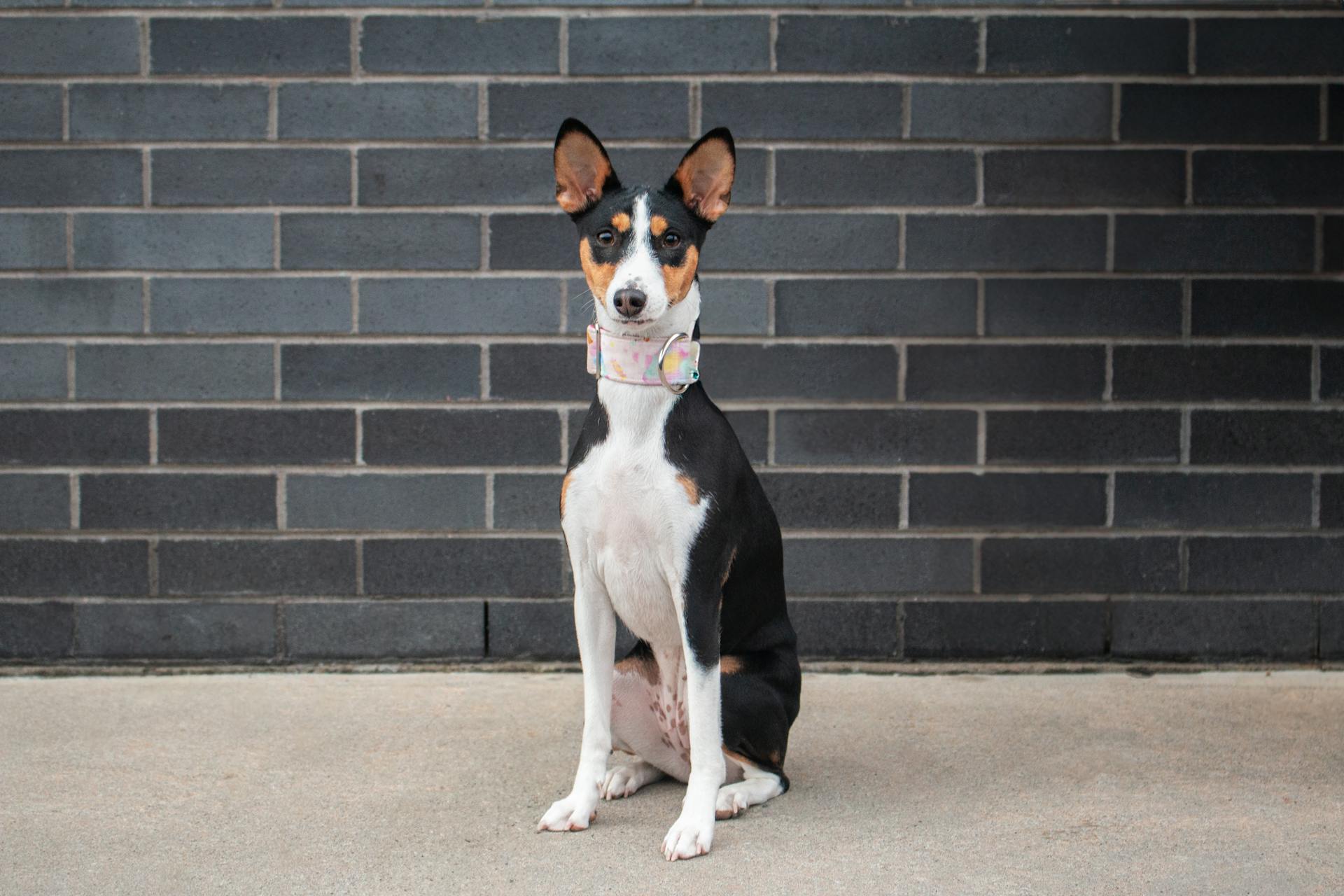
Regular grooming is essential to keep your Basenji looking its best - baths should be needed only every few months, and while they do shed, the short nature of their hair makes it less noticeable than in some other breeds.
To maintain oral health, brush your Basenji's teeth at least two or three times a week, or better yet, daily, to prevent tartar buildup and bacterial growth. This will also help keep his breath fresh!
You'll want to get into the habit of checking for any signs of sores, rashes, or infection on the skin, ears, nose, mouth, and eyes, as well as on the feet - this should become a weekly ritual.
Basenjis are relatively low-maintenance when it comes to grooming, but regular nail trims are essential - if you hear the nails clicking on the floor, they're too long! Short nails will keep your legs scratch-free when your enthusiastic Basenji jumps up to greet you.
Personality and Temperament
The Basenji is a smart and independent hound that can be quite mischievous. They have a knack for getting into things within their reach, whether it's chewing or eating, and are skilled at devising plans to get what they want.
Basenjis need early socialization and training like any other dog, but they can develop selective hearing when something more exciting grabs their attention. This is why patience and a sense of humor are crucial when living with a Basenji.
They tend to become emotionally attached to a single human, which means they thrive on one-on-one interaction. This also makes them wary of strangers, so it's essential to socialize them properly from an early age.
Basenjis have a strong prey drive and will go after cats and other small animals if given the chance. They're also highly curious and love to climb, which can get them into trouble if they're not provided with suitable outlets for their energy.
In terms of training, Basenjis are considered one of the least trainable dogs when it comes to following human commands. However, this doesn't mean they're not intelligent - in fact, they excel at solving problems that benefit themselves, such as finding food or freedom.
Broaden your view: Basenji Training
History and Lineage
The Basenji is one of the oldest dog breeds around, with some thinking it's not even fully domesticated yet!
These ancient dogs have a unique metabolism compared to other domestic dogs, and female Basenjis only have one cycle a year, unlike most other dogs which have two cycles.
Their history dates back thousands of years, with likenesses appearing on ancient Egyptian artifacts, Babylonian, and Mesopotamian artwork. The Basenji was used by people in Africa for hunting, carrying goods, and alerting to dangers.
The Basenji is considered a basal breed that predates the emergence of modern breeds in the 19th century, with DNA studies showing it's closely related to the dingo.
Here are some primitive dog groups the Basenji falls into:
History
The Basenji is an ancient dog breed that dates back thousands of years.
Some of the first domesticated dogs resembled the modern-day Basenji, and its likeness appears on ancient Egyptian artifacts, as well as Babylonian and Mesopotamian artwork. These early ancestors survived as semi-feral dogs in remote locations of Africa for centuries, remaining largely unchanged due to a lack of crossbreeding.
A different take: Chihuahua Basenji Mix Dogs
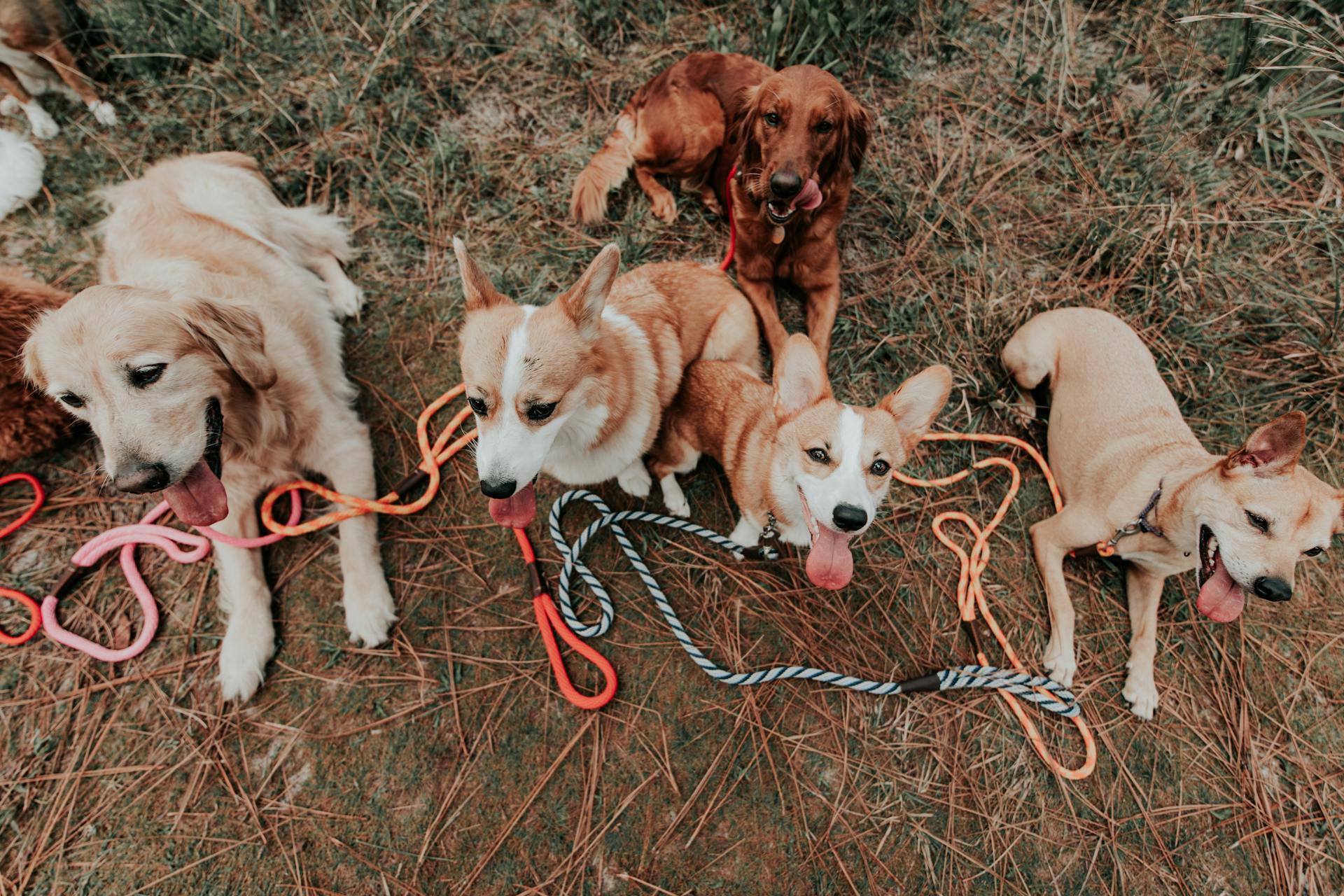
The breed was first described by Europeans in 1895 in the Congo region of West Africa. These local dogs were prized by their owners for their intelligence, courage, speed, and silence.
Basenjis were initially used as hunting dogs, valued for their acute eyesight and sense of smell, intelligence, fearlessness, and athleticism. In some African tribes, a good hunting Basenji was even more valuable than a wife!
It wasn't until the early 1900s that Basenjis began to arrive in the United States, and breeding programs slowly took off.
Broaden your view: Are Basenjis Good Dogs
Lineage
The Basenji is a breed that predates the emergence of modern breeds in the 19th century.
Its lineage has been studied through DNA analysis, which reveals some fascinating facts about its history. The Basenji and the dingo are both considered basal members of the domestic dog clade, indicating they share a common ancestor with other dogs.
One interesting finding from a 2021 genomic study is that the Basenji falls within the Asian spitz group. This suggests that the breed has a unique genetic makeup compared to other dogs.
A unique perspective: Dogs like Basenji
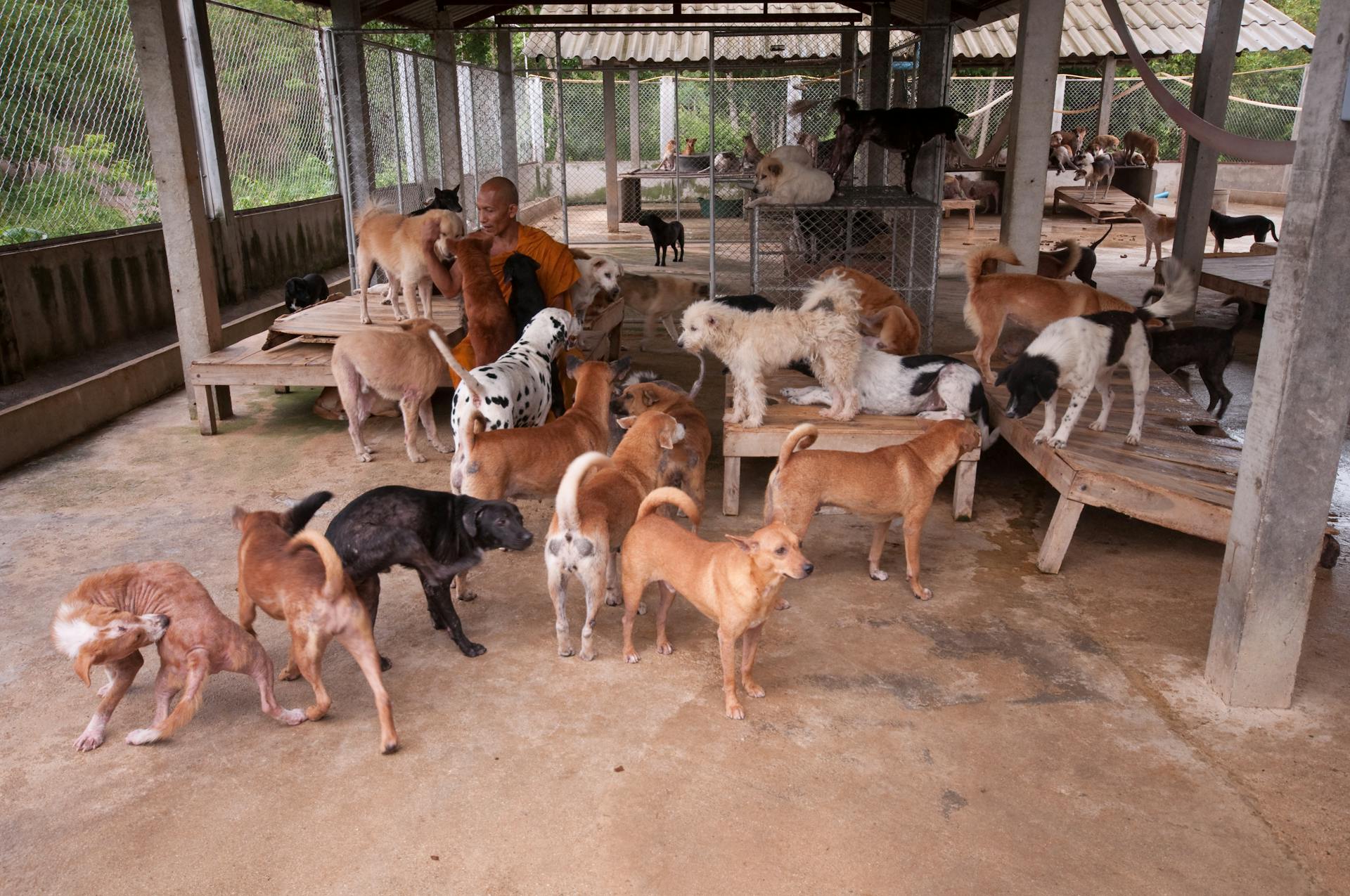
The same study found that the Basenji possesses only two copies of the AMY2B gene, which produces an enzyme called amylase that helps digest starch. This is similar to wolves, huskies, and dingos, which also have only two copies of this gene.
This genetic trait suggests that the Basenji arose before the expansion of agriculture, much like its wild relatives. It's a testament to the breed's ancient origins and its ability to thrive in environments where food was scarce.
Here are some categories of dogs that the Basenji fits into based on its lineage:
The Basenji's lineage is a fascinating topic that highlights its unique place within the world of dogs.
Breed Organizations
Reputable breeders screen their breeding stock for health problems and socialize their puppies from a young age.
This ensures that the dogs they produce make great companions, with healthy and well-adjusted temperaments.
Backyard breeders, on the other hand, are more interested in making a profit than in producing healthy dogs.
Care and Feeding
The Basenji is a hunting dog that requires daily exercise. Some Basenjis are content with a daily walk, while others need more vigorous activities.
You'll want to plan for two 30-minute walks or play sessions every day to keep your Basenji happy and healthy. This can be adapted well to apartment or condo living if you're willing to put in the time.
Basenjis tend to dislike rain, so it's best to avoid taking them for a walk on wet days unless absolutely necessary. However, they may enjoy getting wet on exceptionally hot days.
Pet Feeding Guide
Feeding your Basenji is an important part of their care. The recommended daily amount for adult Basenjis is 3/4 to 1 cup of high-quality dry food per day, divided into two meals.
You'll need to take into account your dog's size, age, build, metabolism, and activity level when determining the right amount of food. Better quality food will be more nutritious and may require less quantity overall.
Basenjis can thrive on a feeding schedule that ranges from once to twice a day. A puzzle feeder is a great way to keep them engaged and stimulated during mealtime, but don't forget to monitor those treats – they're only around 20 pounds, after all!
The amount of food your Basenji needs will depend on their weight, health, lifestyle, and other factors. It's best to consult with your veterinarian for personalized guidance on portion sizes.
Grooming Guide
Grooming is an essential part of your Basenji's care and should be done regularly.
You'll want to brush their short coat once a week to keep it clean, but they generally don't need baths unless they get very dirty.
To maintain oral health, brush your Basenji's teeth at least two or three times a week to prevent tartar buildup and bacterial growth. Daily brushing is even better for gum disease prevention and fresh breath.
Regular nail trims are crucial; if you hear the nails clicking on the floor, they're too long. Short nails keep your legs scratch-free when your enthusiastic Basenji jumps up to greet you.
Start grooming practices early, when your Basenji is a puppy. Get him accustomed to being brushed and examined, especially handling his paws, as dogs can be sensitive about their feet.
A thorough weekly examination will help you detect potential health issues early. Check for any signs of sores, rashes, or infection on the skin, ears, nose, mouth, and eyes, as well as on the feet. Ears should smell pleasant without excessive wax, and eyes should be clear, with no redness or discharge.
Remember to make grooming a positive experience filled with praise and rewards, setting the stage for easy vet exams and handling when he's grown.
Pet Care Considerations
The Basenji is a hunting dog that requires daily exercise, so plan to spend considerable time each day exercising your Basenji.
You'll need to provide regular walks or play sessions, with some Basenjis requiring more vigorous activities than others. They're intelligent and high-energy dogs that can get bored quickly if not engaged.
A couple of 30-minute walks or play sessions every day should suffice for apartment or condo living, as long as you use a leash unless in a securely fenced area. Don't underestimate the Basenji's escape artist skills – they can easily go missing if left unsupervised.
Basenjis tend to dislike rain and might be grumpy if taken for a walk in wet weather. However, they may enjoy getting wet on exceptionally hot days.
Regular grooming is not necessary for Basenjis, but early and consistent training and socialization are important for a well-mannered dog. They have high prey drive, so make sure to keep them on a leash or inside a fenced area when outside.
Basenjis can be wary of strangers and are fastidious about cleanliness – they'll often groom themselves like a cat! With proper care and attention, these African dogs can thrive in their new home.
Spay or Neuter
Spaying or neutering your Basenji can significantly decrease the likelihood of certain types of cancers.
This surgery also eliminates the possibility of your pet becoming pregnant or fathering unwanted puppies, which is a huge relief for many owners.
Performing this surgery gives us a chance to identify and address some diseases your dog is likely to develop.
Other Pets
Basenjis can be a bit wary around other pets, especially if they haven't been raised together.
It's essential to socialize your Basenji with cats and small animals from an early age to prevent chasing and territorial behavior. They should be trusted around these pets only if they've grown up together and recognize them as family members.
Always supervise interactions between Basenjis and other small animals, even if the dog is familiar with them. This will help prevent any accidents or injuries.
If your Basenji sees a cat or other small animal outside, it's likely to chase and try to catch it, so keep an eye on them during outdoor adventures!
Frequently Asked Questions
What is the downside of Basenji?
Basenjis require regular exercise to prevent boredom and destructive behavior
Are Basenjis good pets?
Yes, Basenjis make great family pets due to their loving nature and adaptability. However, they do require regular exercise and may be protective of their families, so proper training and socialization are essential.
Are Basenji dogs expensive?
Yes, Basenji dogs are considered an expensive breed due to their rarity. Prices range from $800 to $4,500 or more for a show-quality puppy.
Is it true that Basenji don't bark?
Basenjis are not capable of barking in the traditional sense due to their unique laryngeal anatomy. Instead, they often produce a distinctive yodeling sound when excited or alert.
Can Basenjis be off leash?
Basenjis are highly independent and have a strong prey instinct, making off-leash training challenging. However, with proper containment or fencing, some owners achieve success
Featured Images: pexels.com
